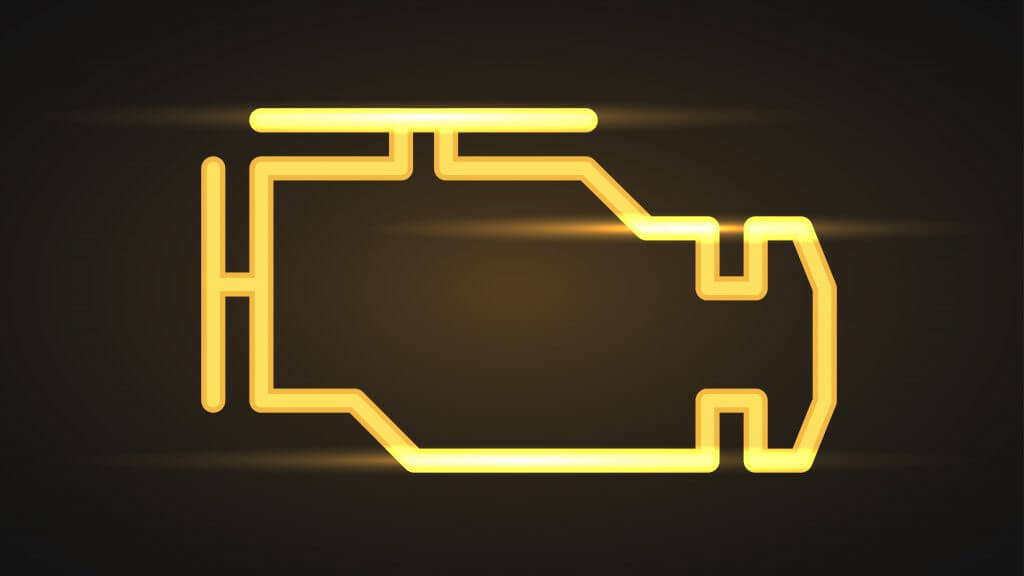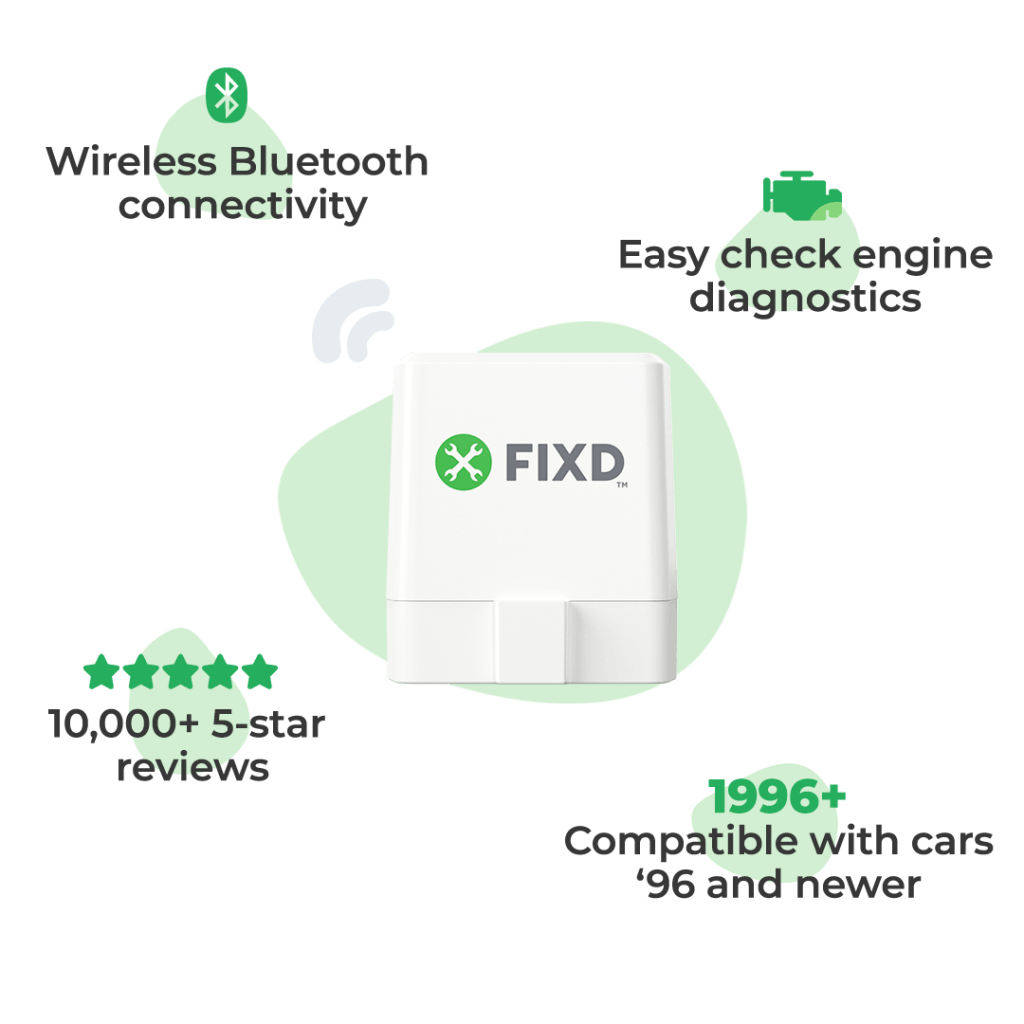FIXD Check Engine Symptom Checker
Use the free diagnostic quiz below to find out the most likely reasons why your check engine light is on and how to fix it.
What Does My Check Engine Light Mean?
If your check engine light is on, you could have a serious problem. Until you know what is causing the problem, you should stop driving. Many of the causes of a check engine light can destroy your engine. It means that there is a problem with your emissions, ignition, fuel or exhaust systems.
Your car’s check engine light is part of the onboard diagnostics system (OBD2).
Why Is My Check Engine Light On?
There are many things that can trigger the check engine light. The most common causes are:
- Loose gas cap
- Misfires/bad spark plugs
- Bad catalytic converter
- Worn O2 sensors
- Worn or dirty mass airflow sensor (MAF)
Common Causes Of The Check Engine Light
Before you fix the check engine light you need to know what is causing the problem. Otherwise, you could end up buying parts you don’t need. The repair for a check engine light can be as simple and cheap as tightening the gas cap or replacing spark plug. It could also be more complicated and more expensive.
These are the most common causes of a check engine light. There are thousands of possible problems though. If you can’t narrow the problem down with this chart, the best thing to do is get a check engine light scanner (OBD2 sensor). You can narrow down the problem to a specific system with a scanner. You can also read your car’s sensors easily to pinpoint the problem so you can save money by fixing the problem yourself. They aren’t expensive devices. You can get a FIXD Sensor for $19.99.
Click here to fix your check engine light with FIXD
Possible Causes Symptoms Severity Most Common Repair
Loose Gas Cap No symptoms other than check engine light Low risk – You can keep driving, but fix the issue soon to make sure it’s not a more serious problem Tighten your gas cap
Worn Spark Plugs Rough idling, decreased power and fuel efficiency
If your check engine light is blinking you have active misfires.Severe – You should stop driving immediately.
Driving with this problem can destroy your engine.Replace your spark plugs, spark plug wires, or spark plug coils
Worn Catalytic Converter A lack of power from the engine, rotten egg or sulfur smell Moderate – Extended driving with this code can cause internal engine damage Replace your catalytic converter
Bad O2 Sensors Black exhaust, rough idle, reduced fuel efficiency, vehicle stalling out Moderate – Extended driving with this code can cause internal engine damage Replace your O2 sensors
Dirty Mass Airflow Sensor (MAF) Black exhaust, rough idle, lack of power from the engine, engine is hard to start Moderate – Extended driving with this code can cause internal engine damage Clean your MAF
Engine Coolant Leak Engine coolant temperature light is on Severe – You should stop driving immediately.
Driving with this problem can destroy your engine.Repair leak with stop leak
Bad Oil Pressure Sensor Oil pressure light is on Severe – You should stop driving immediately.
Driving with this problem can destroy your engine.Replace oil pressure sensor
Most Common Repairs For Check Engine Lights?
Loose Gas Cap ~ Free
This is the first thing you should check because it’s very common and completely free. If the car senses there is a leak in the gas cap it will trigger the check engine light. This isn’t a serious problem, but your car often can’t tell the difference between an open gas cap and a leak somewhere else.
Tighten your gas cap and reset your check engine light. Make sure the check engine light doesn’t come back on or you might have a more serious problem.
If you have a FIXD Sensor, you may see error code P0456
Worn Spark Plugs ~ $75
While a faulty spark plug is a serious problem that you need to repair immediately, it is a simple and cheap repair. You may be able to identify which spark is with an OBD2 scanner. You should confirm this is the problem before buying spark plugs though because you don’t want to waste money on replacing parts that work.
If you have a FIXD Sensor, you may see error codes, P0300, P0301, P0302, etc.
Worn Catalytic Converter ~ $500 – $1500
If you have a faulty catalytic converter, you can keep driving, but you want to fix it soon to prevent more damage. You’ll be able to confirm this is the problem yourself by using an OBD2 scanner. If you see the downstream O2 sensor is jumping around, you need to replace the catalytic converter.
If you have a FIXD Sensor, you may see error code P0420.
Bad O2 Sensors ~ $200
O2 sensors tell the car how much fuel to add to the air/fuel mixture. They’re an important part of your car, so if they’re broken you can keep driving, but fix it as soon as you can. You can save a lot of money by replacing them yourself at home.
You can use an OBD2 scanner like FIXD to read O2 sensors. If you aren’t getting a reading or the reading isn’t what it should be, you may need to replace the O2 sensors.
If you have a FIXD Sensor, you may see error code P0420, P0130, P0131, P0132, P0136, P0137, P0138, P0171, P0172
Dirty Mass Airflow Sensor (MAF) ~ $60
The MAF measures how much air is coming into the engine. This is an important part of your car so you don’t want to drive with a bad MAF for too long. You can save money by doing this repair at home. Use an OBD2 scanner to read the MAF. If you aren’t getting any reading, the sensor is broken and needs to be replaced.
If you have a FIXD Sensor, you may see error code P0101, P0171 or P0174
Engine Coolant Leak ~ $10
If your check engine light and engine temp lights turn on at the same time, stop driving immediately. You may have a leak in your radiator and your engine could break. Engines can cost over $4500. For small leaks you can use a stop leak at home to fix the issue.
Bad Oil Pressure Sensor ~ $60
If your oil pressure sensor and check engine light turn on at the same time, stop driving immediately. The best case scenario is the engine pressure sensor is broken. You can confirm this by reading the sensor with an OBD2 scanner. If the sensor isn’t broken, you may have a leak or are low on oil.
How To Reset A Check Engine Light?
Once you repair your car you should reset the check engine light. You can do this yourself with an OBD2 scanner. Connect your scanner to your car and select “clear check engine light” to turn off the check engine light. It’s important to remember that this doesn’t not fix your car. It only turns off the light.
There are other ways to turn off your check engine light. Read our complete guide on how to reset the check engine light here.
Can I Drive With A Check Engine Light?
There are many things that can cause a check engine light that can destroy your engine. If you don’t know the cause of the check engine light, you should assume the worst. The fastest way to know if you can keep driving yourself is to scan your car with an OBD2 scanner.
Why Is My Check Engine Light Flashing?
When your check engine light is flashing it means that you have an active misfire. This means one or many cylinders in your engine are not working properly. This is very serious and can destroy your engine if you continue driving. Stop driving and fix your car immediately.

At FIXD, our mission is to make car ownership as simple, easy, and affordable as possible. Our research team utilizes the latest automotive data and insights to create tools and resources that help drivers get peace of mind and save money over the life of their car.














